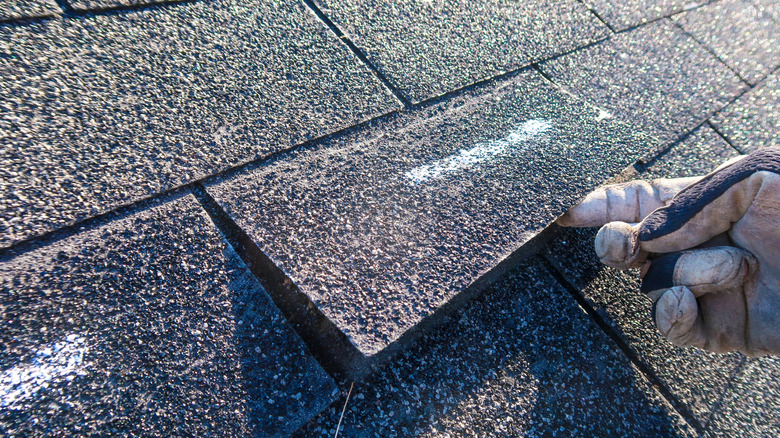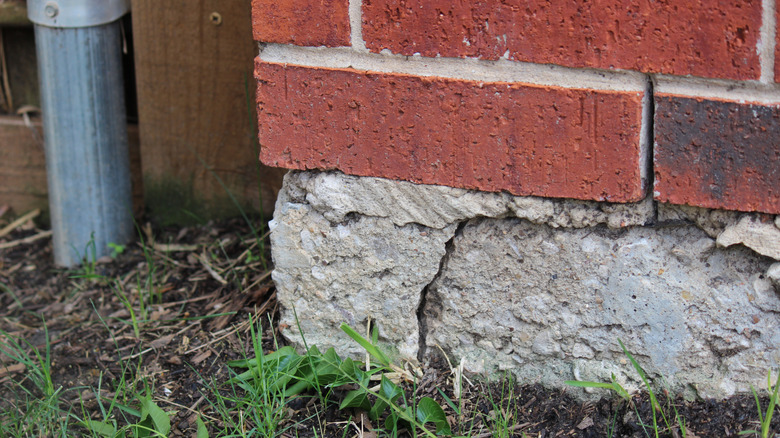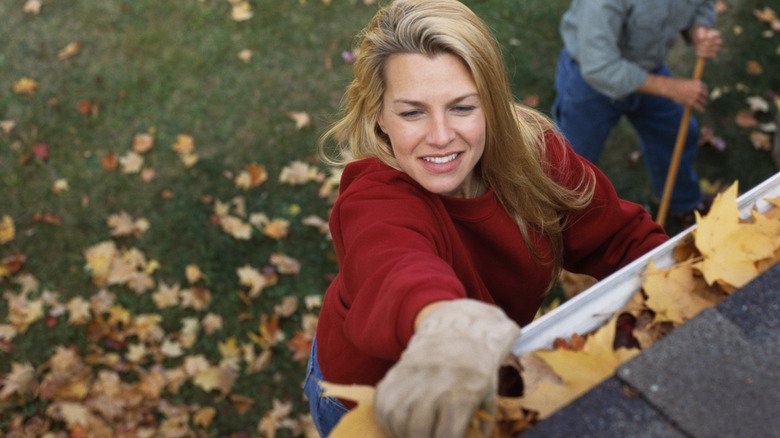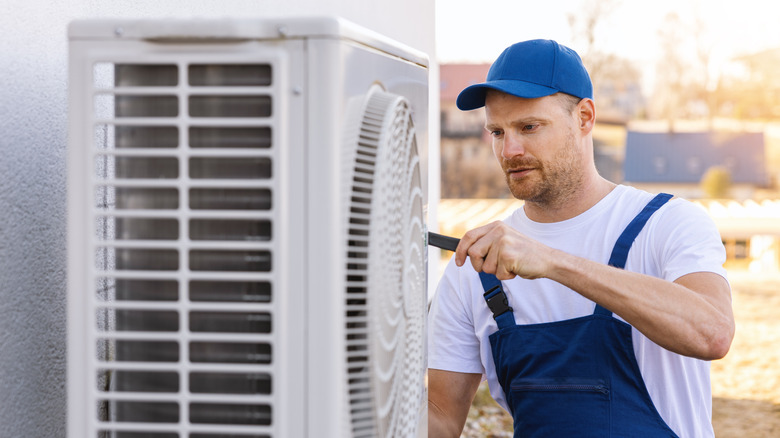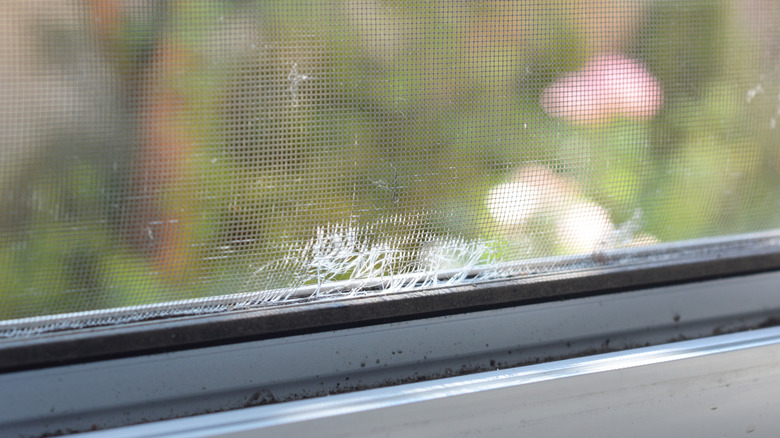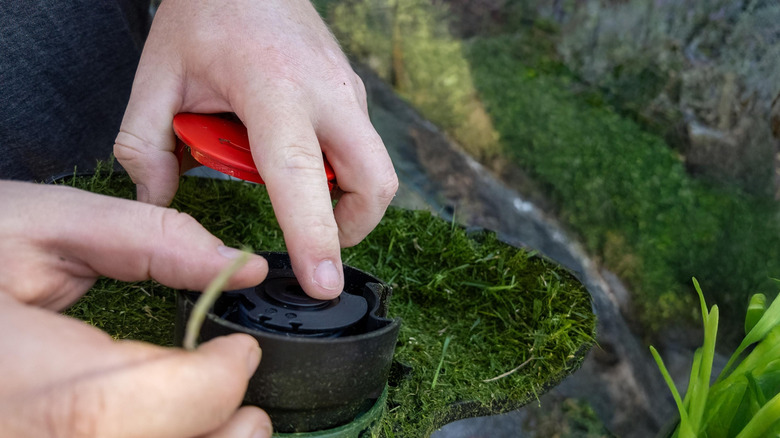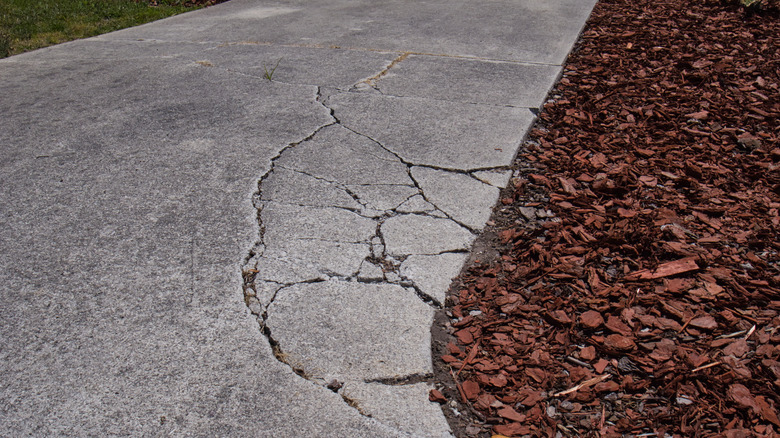Essential Home Maintenance Tasks For Your House This Spring
We may receive a commission on purchases made from links.
Spring signals an end to cold and often snowy weather. As we welcome the warmer seasons ahead and the colorful beauty that comes with them, we hear a lot about how to spring clean a home. And while cleaning your house at this time of the year can certainly be beneficial, it isn't the only thing you should be thinking about. Several maintenance tasks should also be done in the spring to fix any issues that were caused by the harsh winter weather and to ensure your home is ready for the rest of the year.
Failing to complete these home maintenance tasks could prove to be a costly mistake. You could end up losing energy due to inefficient systems or leaks in the siding, compromising your comfort as the temperatures heat up. Or, you may miss minor repairs that could turn into something much more costly in the near future. So, learn more about the essential maintenance tasks you should prioritize this spring to make sure your home is in tip-top condition.
Inspect and repair exterior siding in the spring
The freezing temperatures, snow, and ice that you faced during the winter can cause serious damage to your home's siding. Because of this, taking some time during the spring to inspect the condition of it is essential. It will help you identify any problems before they have a chance to turn into a bigger (and costlier) issue.
When inspecting your home's exterior, there are a few things to look for. First, look closely at each panel to determine whether there are any cracks, chips, or other signs of damage. You will also want to assess whether all of the panels are still firmly attached and lying flat against the house and if there are any noticeable gaps between any two panels. If you notice anything that doesn't look right, you'll want to repair it (or hire a siding company) promptly. Damaged siding can allow moisture to get through. This can cause a whole host of problems, including foundation damage, mold growth, and pest issues.
Depending on the extent of the damage, you may be able to repair it yourself. If there are gaps between the planks, you can seal them. If you have wood siding, you should use an epoxy waterproof exterior wood filler, such as the Gorilla High-Performance Wood Filler. On the other hand, if you have vinyl siding, you should use an acrylic latex caulk, such as the DAP Alex Fast Dry Acrylic Latex Caulk Plus Silicone. If more serious repairs are needed — or you notice signs that your siding may simply be too old and needs to be replaced — contact a professional.
Assess the condition of the roof after a cold and snowy winter
Just as all that snow, ice, and freezing weather can cause problems with your siding, it can also damage your roof. One example of winter weather damage is the formation of ice dams. With all the frozen precipitation that melts and often refreezes, these ice dams may form along the sides of the roof. When this happens, water may find its way under the shingles. Once the temperature drops again, this water will expand as it turns to ice. This may cause the shingles to crack or even fall off altogether. A damaged roof may allow water to get into the home, potentially causing much more serious issues. Heavy ice that has formed over the gutters may also damage them or cause them to become misaligned.
For all of these reasons and more, you should assess the condition of your roof and identify whether any repairs are necessary to counteract the damage that occurred over the winter. Unless you're professionally trained, getting up on the roof yourself is not advisable. So, check if you can see any damage or missing shingles from the ground. If you have attic access, you can also look there for leaks and other signs of a failing roof. If anything seems off at all, call a professional to perform a full inspection.
Check the foundation for any signs of damage
Ice thawing and freezing over the winter also have the potential to damage your home's foundation. Taking the time during the spring to assess the foundation is crucial. Ideally, this inspection should occur early in the spring before those heavy April showers introduce more moisture that could cause further foundation damage.
There are a few signs that can indicate a problem with your home's foundation. One of the most well-known issues to look for is significant cracking along the interior or exterior of the house. Large or deep cracks — especially if you notice that they are increasing in size over time — are not something to overlook. These can indicate that there is a structural problem that you'll want to address quickly.
Walls that aren't standing perfectly straight can also indicate a foundation issue. If any of your home's walls, either interior or exterior, look to be tilted or sloped, it can indicate that the foundation is settling or that there is too much soil pressure. Some other warning signs of potential damage include new gaps along the home's windows and doors, water seeping into the basement, and visible erosion of the soil around the house. If you notice any of these signs, you will want to contact a foundation repair company as soon as possible. Any problems that are left to worsen could spell serious trouble for your home and leave you with even higher repair bills in the future.
Clean the gutters
Gutters should be cleaned a few times during the year. One of the most important times to make sure that they are free of debris is the spring. Even if you cleaned them in the fall, there were likely some straggling leaves left that could be trapped now, along with twigs and other debris. With the rainier months ahead, ensuring that water will be able to flow freely through the system is essential. After all, neglecting to clean your gutters does more harm than you may think. If there are any blockages, you may find yourself facing overflowing gutters, damaged siding, or even water intruding into the home itself.
Cleaning them is a task that you may be able to do on your own, but many homeowners opt to have a professional complete this service for them. If you're not comfortable working on a ladder (while carrying a bucket and other tools to help you dislodge clogs), then you might want to let a pro handle the job for you. If you are going to DIY this maintenance task, just be careful to avoid accidental injury. Ensure that the ladder is on even ground, and wear protective gear, including long pants, a long-sleeved shirt, and gloves, such as the Wells Lamont Nitrile Work Gloves.
Set fans to rotate counter-clockwise
There's a ceiling fan feature you may never have heard about. Did you know that you can change the direction in which the blades spin? This impacts the direction in which the air moves. If the blades are rotating clockwise, it pulls warm air up and sends it throughout the room. This setting is ideal for winter when you want your home to feel warmer. However, once the calendar turns to spring and the temperatures are warming up, you aren't going to want to continue to circulate warm air. Instead, you want the cooler downdraft that blades rotating counterclockwise will produce. When spinning quickly in this direction, a ceiling fan can keep you cool and comfortable even if you set your thermostat a few degrees warmer to save on cooling costs.
Switching their direction shouldn't be too complex. However, the exact steps required will depend on the specific model you have. Check your user's manual, which may tell you to push a button on the remote, flip a switch on the body of the ceiling fixture, or even use a voice command for a smart model.
Hire a professional for a yearly HVAC and generator maintenance call
Spring is the ideal time to look ahead and make sure you're ready for summer weather. Summer temperatures will be hot, and there is always the potential that a strong thunderstorm (or even a tornado or hurricane, depending on where you live) will leave you without power for a few hours or even a few days. Getting your home ready for these conditions during the spring is essential. Your HVAC unit should be working properly to efficiently cool the house, and your home generator (if you have one) should be in good working order and ready to kick on if you lose power.
When you hire a heating and cooling company to service your HVAC unit, they'll check refrigerant levels, make sure all the electrical components are in good condition, and check for any leaks that could impact airflow and overall cooling efficiency. If you have a whole-house generator, scheduling a yearly maintenance check-up for it in the spring will help it operate efficiently. Your technician can assess the engine and wiring, change the oil, test the air intake system, and make sure the unit is fully functional.
Inspect your window screens for any holes or tears
Ah, warm spring weather means that you can finally open up those windows and enjoy some fresh air in the house. While you want to let in the fresh air, you don't want to inadvertently welcome flies, beetles, bees, and other bugs into your home. If you don't add "inspecting your window screens" to your spring maintenance to-do list, you might be doing just that. It is entirely possible that the screens may have ripped, gotten a hole, or become misaligned since you last had your windows open several months ago.
Take time to walk through your home, opening each window and closely inspecting its screen. Gently slide your hand up and down over the mesh to assess whether there are any tears or gaps that could welcome an insect into the home. Ideally, you should remove the screens and clean them before looking for any signs of damage, as doing so will increase the odds of spotting a minor tear. If you identify any holes that are larger than three inches, your best bet will be to replace the screen. Holes that are smaller than three inches, however, can be fixed using a simple patch such as the by.RHO Window Screen Repair Tape.
Tune-up your sprinkler system
Spring is the beginning of the growing season. While there may be plenty of rain that falls in the early spring to help the grass and other plants thrive, summer is often a different story. Taking the time to tune up your sprinkler system ensures your sprinkler system is ready for the hot months and high watering needs ahead.
However, keep in mind that you should not start any tests or tinkering until you're certain that the ground has fully thawed. If the ground is frozen (even up to a foot deep), you're running the risk of damaging the pipes and the system as a whole.
Your tune-up should include making sure the timer is accurate and functioning, as well as replacing the backup battery (if you haven't done so in the past six months or so). You should also clear any rocks or other debris away from the sprinkler heads to ensure they don't obstruct the flow of water. And remember, you really should be cleaning the sprinkler heads about twice a year – in the spring and fall. Be sure to also check the valves for proper functioning (and to identify any leaks that need to be addressed). Then, once you're ready to turn the system on, be sure to slowly open the main valve to prevent a heavy surge of water that could damage the pipes.
Assess the condition of concrete walkways, driveways, and other surfaces and fill in cracks as needed
Remember all those problems that water can cause as it freezes, thaws, and refreezes? Well, sadly, there are other issues that expanding and contracting can cause. And, one of these problems is the formation of cracks on concrete surfaces, such as patios, driveways, and walkways. These blemishes are more than just an eyesore. They also can pose a safety hazard by making the surface uneven and can increase the risk of tripping. Winter may cause other damage to these surfaces. All that salt you throw down to melt ice can eat away at the surface and has the potential to cause it to chip or flake, creating a crumbled surface.
If you find cracks, you can try using a quality concrete repair product to fill them. These sealants and adhesives, like the Quikrete Gray Concrete Crack Seal, will patch cracks and help prevent them from getting bigger. They can also help prevent water from getting through the cracks and causing additional problems.
Assess the deck for any signs of damage and perform thorough upkeep
Spring is also the ideal time to give your deck a good inspection and make sure it is ready for all the time you'll want to spend outside over the coming months. Ice and water expanding and contracting may have damaged the boards over the winter. There could also be trapped moisture that could lead to the growth of mold or mildew if it isn't addressed. So, you won't want to put off this important task. Before you do anything to the deck, give yourself a blank slate to work with by removing all of the furniture and sweeping off any leaves and other debris.
Then, give the deck a good power washing — or hire a professional if you don't know how to do so properly without damaging the wood. Once all that built-up dirt and debris has been washed away, you'll be able to better assess the condition of the wooden boards. Tighten or replace any loose or missing screws or nails. If a few boards are worn, you may be able to replace them instead of deciding that the entire deck is beyond repair. However, it is best to consult with a deck builder to determine the best course of action and make sure that there aren't any major structural issues that you're overlooking.
After thoroughly cleaning your deck, don't forget to apply a new coat of stain (such as the Ready Seal Exterior Stain and Sealer for Wood) or sealant (like Thompson's WaterSeal Clear Multi-Surface Waterproofer). This will help protect the integrity of the wood. Spring is the ideal time to do this as the weather is warm enough to help it dry quickly. Plus, the wood will be protected by the time the blazing hot summer sun makes its appearance. While you're cleaning and re-sealing your deck, don't forget about other wooden structures in your yard, such as a fence or a shed. These could also benefit from a good cleaning, inspection of structural integrity, and a fresh coat of sealant or stain.
Check the plumbing system for functionality and any signs of damage
Assessing your home's plumbing system is another essential spring home maintenance task. That freezing winter weather has the potential to cause damage to the pipes and appliances in your home, and you'll want to identify any issues before they turn into a major plumbing catastrophe. A leak — even if only a very small one — can cause serious water damage, create an ideal environment for mold to grow, and increase your utility bills. Take time to check under each sink for any signs of dripping water or moisture.
One other part of your plumbing system that you should check is the sump pump. You want to make sure it is running properly to avoid a flood with all the incoming spring rain showers. Additionally, take some time to look over your water heater, the outdoor faucets, the washing machine, and the garbage disposal. Because of how devastating and costly a water leak can be, you may want to hire a plumber. They will be able to assess your system as a whole and identify any problematic areas that you might miss.


